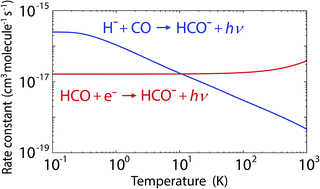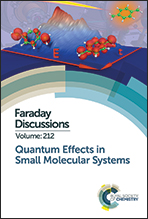On the gas-phase formation of the HCO− anion: accurate quantum study of the H− + CO radiative association and HCO radiative electron attachment
Abstract
The hydrogen anion has never been observed in the interstellar medium, but it is most likely present in some interstellar regions. Since direct detection appears especially difficult, improving the knowledge of the astrochemical processes involving this anion should be valuable in defining a way of indirect detection. We present the first study of the radiative association of H− and CO to form the HCO− anion within a quantum time-independent approach. We use a state-of-the-art potential energy surface which has been calculated for the present study. The calculated radiative association rate coefficient is monotonically decreasing from 6 × 10−16 to 5 × 10−19 cm3 per molecule per s across the 0.01–1000 K temperature range. At the typical temperature of the cold interstellar medium, ∼10 K, the radiative association rate is ∼2 × 10−17 cm3 per molecule per s. On the other hand, the plane wave approximation is used to calculate the HCO radiative electron attachment rate coefficient. It is found to be almost constant and also equal to 2 × 10−17 cm3 per molecule per s. Setting aside the question of the abundances of the reactants of both processes, these results demonstrate that among the two gas-phase modes of production of the HCO− anion in cold interstellar medium considered in this study, the H− + CO radiative association is dominating below 10 K while the radiative electron attachment rate is larger above 10 K.

- This article is part of the themed collection: Quantum effects in small molecular systems


 Please wait while we load your content...
Please wait while we load your content...